There’s a reason we call our pets furbabies—they may not be of a different species, but they’re family. And we always want the best for our family. There’s a wide range of quality dog food and treats available, but sometimes, we want to treat Tagpi to something special. And what could be more special than something that we’ve made ourselves?
“Preparing food for your pet gives you the peace of mind, knowing that what they’re eating is fresh and nutritious,” says Tim Muñoz of Manila Bulletin.
Cooking for your dog is not as hard as it seems. “All you really need to know is what they’re not supposed to eat (like garlic, onion, grapes, apple seeds, citrus fruit, chocolate, etc.) and keep those away from their bowls. Once you have that figured out, it’s just a matter of trial and error to see what your pet likes,” Muñoz says. When you think about it, it’s kind of like cooking for a person with a lot of food allergies.
Pet owners should take into account their pet’s nutritional needs. Meat, for example, is important. Also, while humans prefer food with strong tastes, pets don’t feel the same way. “Dogs, like cats, are obligate carnivores. They benefit the most from meat since they’re able to digest and synthesize the nutrients from meat best. If feeding kibble, look for ‘grain free’ kibble,” he adds. “Owners need to understand that pet food needs to be bland for the health and safety of their pets. While they may like human food, their bodies aren’t equipped to deal with all the salt, sugar, spices, and fat normally found in what we eat.”
No-Bake Kamote & Peanut Butter balls
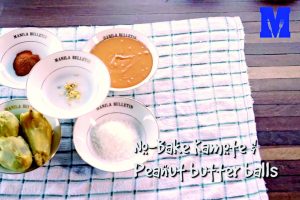
“The kamote balls are my take on the more popular ‘pumpkin balls’ people feed their dogs. I wanted to do a more Filipino take on the treat, so I chose to replace pumpkin with kamote,” Muñoz says.
Ingredients:
- 300 g boiled kamote cubes
- 100 g creamy peanut butter
- ¼ tsp ground ginger
- Cinnamon
- Coconut flour
Procedure:
- Mash warm kamote in a bowl
- Add in peanut butter and ginger
- Shape into balls
- Roll balls in either coconut or cinnamon
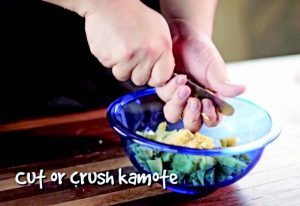
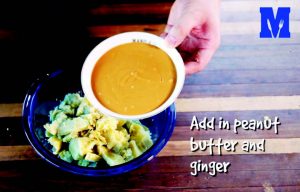
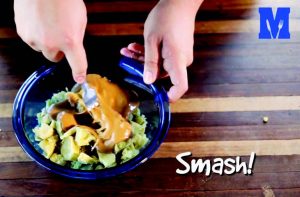

Muñoz, who owns a dog and a cat, makes his own nutritious ‘soup’, which he affectionately calls ‘slop’. He boils 2 kilograms of chicken livers (it usually has hearts and gizzards in it too) and 1 kg meat shop ‘sawdust’ (ground offcuts) with 1 liter of water until cooked, then leaves the mixture to cool. Once cool, he pulses everything in batches in a blender or food processor till the chunks become as small as pebbles. He shapes the chunks into individual portions (about 100 grams per day for a medium-sized dog), and freezes the portions that cinnamonwon’t be used in the next five days. One batch makes enough slop for a month, but portions will depend on the size and appetite of the pet. Defrost before serving, mix with grain-free kibble.
Muñoz also concocted a couple of fancy, dog-approved treats for MBites: Kamote Balls and Chicken Terrine. “They are (edible for humans),” Muñoz says. “Whether or not they’re palatable is a different question. A few colleagues and I actually enjoyed eating the kamote balls.”
Chicken and Egg Terrine
“The chicken terrine is based on how Europeans transport meat in gelatin to keep it fresh,” Muñoz says. “I figured that since gelatin is made of animal protein, it might as well be part of the treat.”
Ingredients:
- 1 can canned chicken in water
- 3 hard boiled eggs
- ¼ tsp turmeric powder or ground turmeric
- ½ envelope gelatin, dissolved in ¼ cup cold green tea
- ¼ cup hot green tea (for antioxidants)
Procedure:
- Mash the canned chicken and boiled eggs together
- Mix cold diluted gelatine, turmeric, and hot tea, then pour onto chicken mixture
- Mix well
- Place chicken mixture into ice cube trays and chill for at least four hours
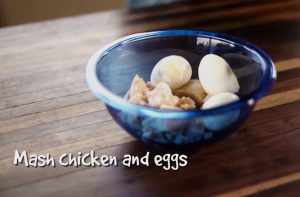
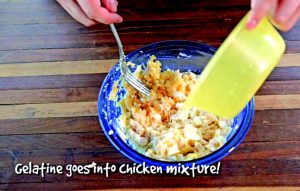

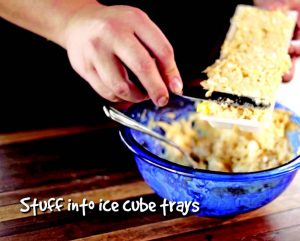
MBites tested the pumpkin balls and chicken terrine on Jack, a Pomeranian. (Find out how the recipes fared at mbites.ph.)
This appeared in Animal Scene magazine’s March 2018 issue.






